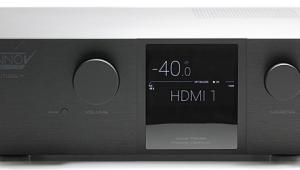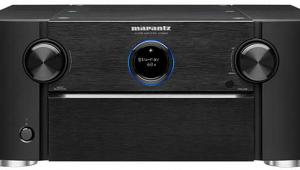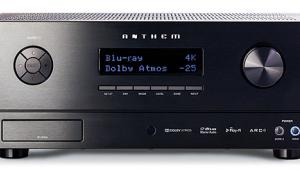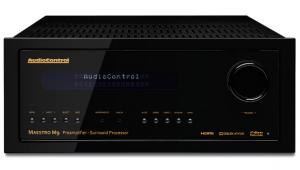Parasound Model 7100 Surround Controller and Model 5250 Amplifier
My curiosity was naturally piqued a few years ago when I heard that Parasound was going upscale with their look. This was a company that had become virtually synonymous with performance plus value, facilitated somewhat by forgoing aesthetic flair, and I wondered where the decision to go uptown with the finish in the Halo line would lead. The first good sign was the Halos' higher price tags. It costs a lot more to make boxes look that good, and this told me that they weren't taking resources away from performance to do so. What ultimately satisfied my curiosity, though, was how good the Halo models sounded. Yet, there are still those who want Parasound performance, have less to spend, and don't mind—or maybe even appreciate—Parasound's rugged, utilitarian old style. The New Classic line is exactly what they're looking for.

Besides carrying the banner for Parasound's traditional look, the New Classic models are also designed with an eye toward custom installations. The new 7.1-channel Model 7100 surround controller's flexibility, ease of use, and back panel are a testament to that. Its two-way RS-232 port allows you to connect it to more advanced control systems, and it offers a high degree of futureproofing through software upgrades (some of which are available over the Internet). PC-based setup software, or the setup tutorial DVD, makes creating multiple configurations—and backing up those configurations—rather easy. There's also an expansion port earmarked for HDMI. IR jacks and 12-volt triggers are plentiful. Several digital and analog audio inputs and outputs are aboard, along with several video ins and outs (including hand-bandwidth component connections). There's also support for a second zone and a 7.1-channel input with optional bass management.
Processing is fully loaded with every Dolby and DTS format, including Dolby Pro Logic IIx. THX Ultra2 certification adds THX postprocessing, as well. Internals are first-rate, including a Motorola 56367-7 DSP engine and 24-bit/192-kilohertz digital-to-analog converters.
The Model 5250 five-channel amplifier is nicely outfitted, as well. It is the powerhouse of the New Classic amp line, putting out 250 rated watts per channel with all channels driven and ample amounts of current. It uses a pair of healthy-sized toroidal transformers and fully discrete circuitry throughout. It, too, is THX Ultra2–certified, which means that it's already been beaten on plenty—and withstood the rigors. The single-ended (RCA) inputs and five-way binding posts are gold-plated, and 12-volt triggers complete the back panel.
Setup is a breeze, thanks to an excellent remote and a simple, intuitive onscreen menu. Access to the more advanced controls is easy, but the basic setup mode should be entirely nonintimidating to the technophobic, even without help from the setup software. I paired the Parasound combo with Energy's rock-solid Veritas V2.4 towers, V2.0C center channel, and V2.0R surrounds, along with Marantz's DV8300 universal player, for a 5.1-channel system that I expected would outperform its price tag on all fronts.
 I immediately liked what I heard from the Model 5250 with CD material. Big wattage ratings don't always equate to big power, or big current, in the listening room—but they did here. The two things I look for right away with the Veritas V2.4s are an amp's ability to drive their occasionally laid-back upper-bass frequencies and the ability to keep the sometimes exuberant top end under control. Pink Floyd's "Another Brick in the Wall" from the second Burmester collection quickly demonstrated the Model 5250's ability to do both. The variety of lower percussive sounds that are the driving force of this track, and which run the full gamut from lower midrange to lower bass, were perfectly balanced and every bit as punchy on the high side as on the low side. Meanwhile, the ever-present cymbals, which obviously put the high frequencies to the test, had bite and finesse without any excess sibilance or sizzle. With the right amp behind them, the V2.4s are as good a set of midpriced speakers as you'll find, and the Model 5250 proved that powerfully.
I immediately liked what I heard from the Model 5250 with CD material. Big wattage ratings don't always equate to big power, or big current, in the listening room—but they did here. The two things I look for right away with the Veritas V2.4s are an amp's ability to drive their occasionally laid-back upper-bass frequencies and the ability to keep the sometimes exuberant top end under control. Pink Floyd's "Another Brick in the Wall" from the second Burmester collection quickly demonstrated the Model 5250's ability to do both. The variety of lower percussive sounds that are the driving force of this track, and which run the full gamut from lower midrange to lower bass, were perfectly balanced and every bit as punchy on the high side as on the low side. Meanwhile, the ever-present cymbals, which obviously put the high frequencies to the test, had bite and finesse without any excess sibilance or sizzle. With the right amp behind them, the V2.4s are as good a set of midpriced speakers as you'll find, and the Model 5250 proved that powerfully.
The love fest between the Model 5250 and the V2.4s continued with high-resolution and/or multichannel material. The Model 5250 didn't appear to sweat any more with all channels driven than it did in stereo. This was obvious with the DTS 5.1 "stage mix" from AIX's DVD-Audio of Respighi's Pines of Rome, which puts the listener in the middle of the orchestra and thus demands significantly more from the surrounds than the standard "audience" perspective. I even temporarily substituted a pair of full-range Phase Technology towers in back to get the full effect. The Model 5250 responded vigorously and was entirely un-phased by the peculiarities of the context. It didn't shy away from the perspective or the full-range surrounds. In fact, it seemed to relish the opportunity to strut its stuff with a big, powerful bottom end, smooth midrange performance, and entirely stable—but still entirely exciting—upper frequencies. As I switched over to high-resolution multichannel material, the Model 7100 still played its part by not playing a noticeable part at all. You know a preamp is doing its passthrough job properly when you run the disc player directly into the amp and notice no difference between that sound and that which you get when you route the player through the preamp.
The Model 7100 returned to a more active role with movies, and the Model 5250 continued to impress. The Model 7100 offers about as many playback options for movies as you'll find, and I spent a lot of time in the THX Ultra2 Movie mode, in addition to basic Dolby Digital 5.1 and DTS. Whatever the format or the material, the Model 7100 was smooth and precise throughout. The Model 7100 and Model 5250 delivered impressive immediacy and excitement with Band of Brothers, particularly during the dense combat scenes. The air seemed to be lethal with projectiles during the assault on Foy, with small shells ripping around overhead and big shells providing the knockout punch, creating big, foundation-rattling blasts. Even when I cut out the sub, the V2.4s and the Parasound combo conspired to ruffle my pant legs with deep, powerful bass. Musically driven soundtracks were no less satisfying. Hero supplies a curious blend of hauntingly powerful music intermixed with swordplay and other action, which the Parasound combo sorted out and reproduced flawlessly. As for dialogue, I find that using Hero's Chinese track allows me to concentrate more on the sound of the words than on the words themselves, and this combo passed that test with flying colors, too.
Parasound truly takes the time to do things right, and the Model 7100 and Model 5250 are further evidence of that. When Parasound set about making value-priced home theater gear, the result was some of the strongest-performing midpriced gear on the market. When they decided to go upscale with their look, the result was the beautiful Halo line. And, with their decision to pay tribute to what got them here, the result is the Model 7100 and Model 5250, a pairing that immediately ups the ante in the midpriced separates ranks, and its combination of performance, value, and features is going to be a very difficult combination to beat. If you're in this market, put it on your short list today.
Highlights
• Smooth, powerful sound with movies and music
• Ample connections, features, and processing options
- Log in or register to post comments


























































